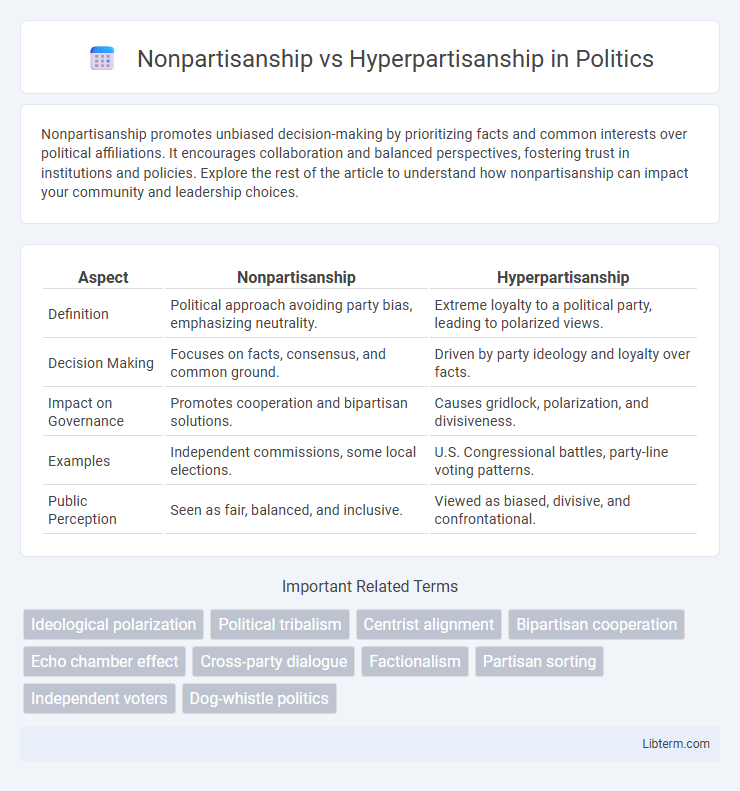Nonpartisanship promotes unbiased decision-making by prioritizing facts and common interests over political affiliations. It encourages collaboration and balanced perspectives, fostering trust in institutions and policies. Explore the rest of the article to understand how nonpartisanship can impact your community and leadership choices.
Table of Comparison
| Aspect | Nonpartisanship | Hyperpartisanship |
|---|---|---|
| Definition | Political approach avoiding party bias, emphasizing neutrality. | Extreme loyalty to a political party, leading to polarized views. |
| Decision Making | Focuses on facts, consensus, and common ground. | Driven by party ideology and loyalty over facts. |
| Impact on Governance | Promotes cooperation and bipartisan solutions. | Causes gridlock, polarization, and divisiveness. |
| Examples | Independent commissions, some local elections. | U.S. Congressional battles, party-line voting patterns. |
| Public Perception | Seen as fair, balanced, and inclusive. | Viewed as biased, divisive, and confrontational. |
Understanding Nonpartisanship: Definition and Principles
Nonpartisanship refers to the practice of avoiding affiliation with any political party, emphasizing impartiality and objective decision-making based on facts and common good rather than party ideology. Core principles include neutrality, fairness, and a commitment to serving all constituents equally without bias. This approach fosters trust in governance by prioritizing evidence-based policies and collaborative problem-solving over partisan agendas.
What is Hyperpartisanship? Key Characteristics
Hyperpartisanship refers to an extreme, rigid loyalty to a political party or ideology, often leading to polarized and uncompromising stances on policy issues. Key characteristics include intense partisan bias, rejection of opposing viewpoints, and prioritizing party success over bipartisan cooperation or national interest. This phenomenon contributes to legislative gridlock and increased political polarization in democratic systems.
Historical Context of Partisanship in Politics
Throughout U.S. history, partisanship has evolved from the Founding Fathers' warnings of factionalism to the modern era's sharply divided political landscape. Early political parties like the Federalists and Democratic-Republicans established the foundation for organized political competition, while the 20th and 21st centuries witnessed increasing polarization driven by ideological, social, and media influences. Nonpartisanship efforts emerged during periods of national crisis, such as World War II and civil rights movements, highlighting attempts to balance governance with bipartisan cooperation in contrast to the prevailing hyperpartisanship seen in recent decades.
The Impacts of Nonpartisanship on Governance
Nonpartisanship fosters collaborative decision-making by minimizing ideological conflicts, leading to more effective and inclusive governance. It promotes policy solutions based on consensus and evidence rather than party loyalty, enhancing government transparency and public trust. Nonpartisan approaches reduce polarization, enabling smoother legislative processes and stable governance in diverse political environments.
Consequences of Hyperpartisanship in Society
Hyperpartisanship erodes democratic institutions by deepening political polarization and reducing bipartisan cooperation, leading to legislative gridlock and ineffective governance. It fosters social division and distrust, as citizens increasingly identify with rigid party lines rather than shared national interests. This environment hampers constructive dialogue and undermines public confidence in political processes, destabilizing societal cohesion.
Nonpartisan Approaches to Policy Making
Nonpartisan approaches to policy making emphasize evidence-based research, stakeholder engagement, and consensus-building to create balanced and effective solutions. This method reduces political bias and prioritizes public interest, fostering policies that are more sustainable and broadly acceptable. By focusing on data-driven analysis and cross-ideological collaboration, nonpartisan policy frameworks enhance transparency and trust in governance.
Media Influence: Fueling Hyperpartisanship
Media influence plays a critical role in fueling hyperpartisanship by prioritizing sensationalist content that deepens political divides and reinforces echo chambers. Algorithms on social media platforms amplify emotionally charged and partisan messages, increasing polarization among audiences. This dynamic undermines nonpartisan discourse by promoting biased narratives and hindering objective information sharing.
Bridging the Gap: Strategies for Reducing Polarization
Bridging the gap between nonpartisanship and hyperpartisanship requires fostering open dialogue that prioritizes shared goals over party allegiance. Implementing bipartisan policy-making frameworks and encouraging collaborative leadership can reduce political polarization. Emphasizing media literacy and promoting diverse news consumption also help mitigate echo chambers that deepen partisan divides.
Case Studies: Nonpartisan vs. Hyperpartisan Outcomes
Case studies reveal nonpartisan approaches often yield balanced policymaking, fostering collaboration and sustainable solutions, as seen in Switzerland's consensus-driven system. Hyperpartisan environments, exemplified by the U.S. Congress during government shutdowns, tend to produce legislative gridlock and heightened political polarization. These contrasting outcomes underscore the impact of political dynamics on governance effectiveness and public trust.
The Future of Political Discourse: Finding Common Ground
Nonpartisanship promotes collaborative policymaking by prioritizing shared goals over party loyalty, fostering an inclusive political environment that encourages compromise and constructive dialogue. Hyperpartisanship, characterized by extreme loyalty to party ideologies, often leads to gridlock and polarizes public opinion, undermining effective governance. Bridging the divide requires institutional reforms and civic education aimed at enhancing bipartisan cooperation and restoring trust in democratic processes.
Nonpartisanship Infographic

 libterm.com
libterm.com